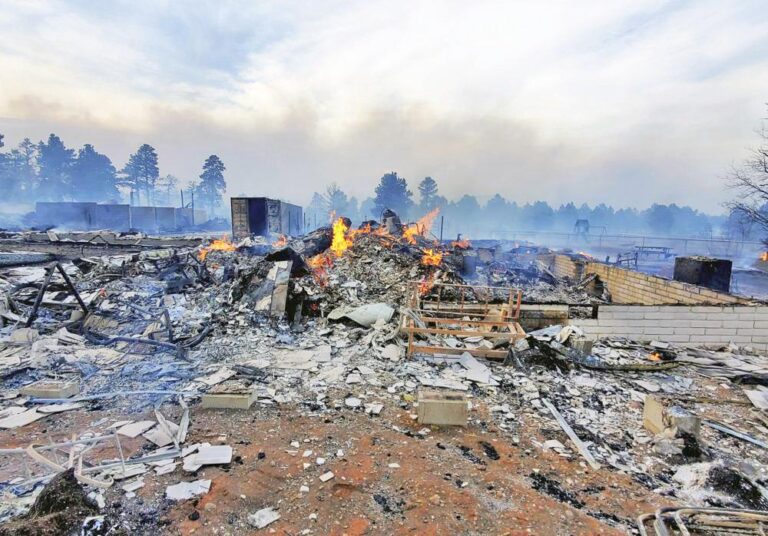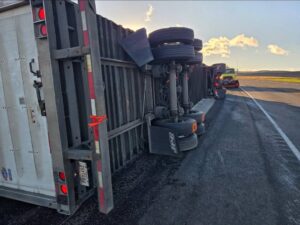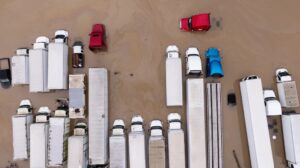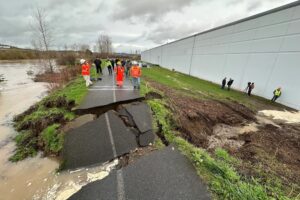UPDATE | April 22
US 89 closed north of Flagstaff
U.S. 89 is closed in both directions north of Flagstaff due to the Tunnel Fire. The northbound lanes are closed at milepost 425; the southbound lanes are closed at milepost 445. There is no estimated reopening time.
Alternate routes
Take westbound I-40 to SR 64 north, and take that around to US 89. Another alternate route is I-40 east to northbound SR 87, SR 264 west to U.S. 160 west, to U.S. 89.

FLAGSTAFF, Ariz. — Firefighters working to keep more homes from burning on the edge of a mountain town in northern Arizona were treated to scattered showers and cooler temperatures early Friday, but the favorable weather was not expected to last as more ferocious winds were forecast to batter parts of Arizona and all of New Mexico through the weekend.
Flames stretching 100 feet had raced through rural neighborhoods near Flagstaff just days earlier. It wasn’t until Thursday that a break in the weather allowed authorities to enter the charred area to survey the damage. They found 30 homes and numerous other buildings had been destroyed, with sheriff’s deputies saying more than 100 properties were affected.
Crews have cleared containment lines around much of the fire but it remained officially at zero containment because of concern the lines might not keep the fire in check during strong winds, fire spokesman Dick Fleishman said Friday.
Spirits were lifted Thursday as helicopters were able to start dropping water on that blaze for the first time. It has burned close to 32 square miles, forced evacuations of 765 homes and destroyed at least two dozen structures since it broke out on Sunday.
Aerial attacks also resumed in northern New Mexico on Thursday, where at least one airtanker was able to join the effort northeast of Santa Fe — something that will be impossible on Friday.
Fire managers there said that without air support and no crews working directly on the fire lines due to the weather, explosive growth was expected.
“It’s definitely lining up to be a very dangerous situation,” San Miguel County Sheriff Chris Lopez said during a community meeting Thursday night, pleading with residents to take the evacuation orders seriously.
Authorities on Friday morning started evacuating several tiny communities in the valleys northeast of the fire as officials expected it to overtake some of those areas by the end of the day. They said flames could spread as much as 13 miles in that direction. Several roads in the area were also closed.
Sustained winds of 30-50 mph were forecast, with gusts from 60-80 mph in the afternoon from the Gila Mountains up through the Rio Grande Valley to neighboring highlands.
The combination of the high winds, warmer temperatures and extremely dry conditions will make for an atmosphere that’s “pretty much on steroids,” said Scott Overpeck with the National Weather Service in Albuquerque.
“This is not typical,” he said, looking ahead to what he said could be potentially explosive fire growth on Friday. “This is really one of those days we need to be on our toes and we need to be ready.”
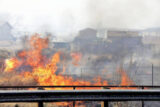
Wildfire has become a year-round threat in the West given changing conditions that include earlier snowmelt and rain coming later in the fall, scientist have said. The problems have been exacerbated by decades of fire suppression and poor management along with a more than 20-year megadrought that studies link to human-caused climate change.
Colorado saw one of its most destructive wildfires last winter, when flames tore through two densely populated Denver suburbs. While crews in that state got a handle this week on two small wildfires, Gov. Jared Polis was scheduled Friday to talk about the ongoing danger and how state officials planned to deal with what was expected to be a significant fire season.
In Arizona, popular lakes and national monuments have closed — including Sunset Crater Volcano National Monument outside Flagstaff because the wildfire moved directly over it, blackening trees, and burning tools and vehicles in a maintenance yard, said monument spokesman Richard Ullmann.
The Coconino National Forest has closed the area where the wildfire is burning but has not enacted broader fire restrictions or closures. A sign at a gate warns of potential loose debris, falling trees and branches, and flash floods.
Fire restrictions go into effect Friday at some National Park Service sites in New Mexico, including Valles Caldera National Preserve and Bandelier National Monument.
UPDATE | April 21
US 89 closed north of Flagstaff
U.S. 89 is closed in both directions north of Flagstaff due to the Tunnel Fire. The northbound lanes are closed at milepost 425; the southbound lanes are closed at milepost 445. There is no estimated reopening time.
Alternate routes
Take westbound I-40 to SR 64 north, and take that around to US 89. Another alternate route is I-40 east to northbound SR 87, SR 264 west to U.S. 160 west, to U.S. 89.
FLAGSTAFF, Ariz. — Fire managers across the Southwest are reckoning with strong winds that forecasters say could lead to explosive growth in wildfires this week. Hundreds of people were evacuated in numerous blazes that have scorched structures and signaled an early start to the fire season.
A wildfire on the outskirts of Flagstaff continued its run Wednesday though dry grass and scattered Ponderosa pines around homes into volcanic cinder fields, where roots underground can combust and send small rocks flying into the air, fire officials said. Aircraft was grounded for a second day due to high winds, and a major northern Arizona highway remained closed as smoke shrouded the air.
Winds are expected to ramp up Thursday after easing up a bit Wednesday. Friday has a chance of precipitation but even stronger winds followed by a dry forecast into next week, said Brian Klimowski of the National Weather Service.
“Folks, we have entered our fire season,” he said. “It’s going to be a long one this year.”
Resources are tight around the Southwest as multiple wildfires burn. Four of the 16 top-level national fire management teams are dedicated to blazes in Arizona and New Mexico — something fire information officer Dick Fleishman said is rare this early in the season.
At a community meeting in Flagstaff, residents questioned how a small blaze reported northeast of the city Sunday afternoon ballooned to more than 30 square miles (77 square kilometers) by Wednesday afternoon. Matt McGrath, a district ranger on the Coconino National Forest, said firefighters had corralled the wildfire Sunday and didn’t see any smoke or active flames when they checked on it again Monday.
By Tuesday, the wind was firmly in control. Flames emerged and jumped the containment line, leaving firefighters and McGrath to ask themselves if they could have done something differently, he said.
“I can’t tell you for sure, but I don’t think so,” McGrath said. “And I know that’s not a satisfying answer with everything you’re going through right now.”
The cause of the fire is under investigation. Firefighters have yet to corral any part of it.
Hundreds of people have been evacuated in Arizona and New Mexico because of wildfires.
“This is a heads-up for everywhere else in the state,” said Fleishman. “If you have dry grass up next to your house, it’s time to get that cleaned up.”
In New Mexico, the Mora County Sheriff’s Office expanded evacuation orders as winds fueled a 14 square-mile (36 square-kilometer) blaze. A new fire emerged Wednesday in a wooded area along the Rio Grande south of Albuquerque.
In Colorado, new wildfires prompted evacuations in Monte Vista, a city of about 4,150 people in the southern part of the state, and near Longmont. An undetermined number of structures burned but no one was injured, authorities said.
“We struggled at times to stay in front of this fire and stay out of the way of it because the winds and stuff were so strong,” said Monte Vista Police Chief George Dingfelder.
The number of acres burned in the U.S. so far this year is about 30% above the 10-year average — a figure that has gone up from 20% just earlier this month as the fire danger shifted from the southern U.S. to the Southwest. Above-average temperatures and below-average precipitation have combined with spring winds to elevate the risk of catastrophic fires.
On the outskirts of Flagstaff where tourists and locals revel in hiking and horseback riding trails, camping spots, and the vast expanse of cinder fields for off-road vehicle use, flames soared as high as 100 feet (30 meters) at times. Popular national monuments including Sunset Crater Volcano and Wupatki were closed because of the wildfire.
“It’s just a unique community and we’re fortunate to live here,” said Jon Stoner, who evacuated his home Tuesday. “We feel very lucky with the views we have and the surrounding forest.”
About 200 residents attended the community meeting Wednesday in Flagstaff at a middle school that’s also being used as a shelter. Some lost their homes — part of the estimated 25 structures that have been lost — and were worried about finding temporary housing in a city where rental prices have exploded in recent years. One woman who was evacuated from the forest where she was camping wondered when she might be able to retrieve her things.
Coconino County officials pointed residents to a system set up to offer assistance. Sheriff Jim Driscoll couldn’t say when residents might be allowed back home. Some 765 homes were evacuated.
“There’s still active firefighting going on in those areas, and we need to have it safe for you to go in,” he said.
U.S. 89, the main route between Flagstaff and far northern Arizona, and communities on the Navajo Nation, remained closed.
Other residents asked when the U.S. Forest Service would begin restricting campfires or closing the forest to all visitors. McGrath said banning campfires isn’t a silver bullet but ensured the audience that the U.S. Forest Service and other agencies already are talking about when to enact restrictions.
Lisa Wells is among the residents whose home was burned. She said she saw a puff of smoke outside her window Tuesday. Before long, the smoke blackened, the wind gained strength and entire trees were being consumed by flames.
In what felt like seconds, her family moved from being ready to go to fleeing. Wells grabbed medication, and the family got themselves, their alpacas, horses and dogs to safety, but left some animals behind.
“It was a miracle that people got out because we had so little time,” Wells said.
Birds, goats and chickens they left behind didn’t survive the fire. The family now is staying at a hotel where their dogs also are welcome.
Elsewhere in Arizona, a wildfire burned 2.5 square miles (6.5 square kilometers) of brush and timber in the forest about 10 miles (16 kilometers) south of Prescott. Several small communities that included summer homes and hunting cabins were evacuated.
PREVIOUS STORY | April 20
FLAGSTAFF, Ariz. — U.S. 89 is closed in both directions north of Flagstaff due to a major wildfire.
The northbound lanes are closed at milepost 423; the southbound lanes are closed at milepost 445.
There is no estimated reopening time, according to the Arizona Department of Transportation.
ADOT suggests an alternate route of westbound Interstate 40 to SR 64 north, then taking that road around to U.S. 89.
Another alternate route is I-40 east to northbound SR 87, SR 264 west to U.S. 160 west, to U.S. 89, according to ADOT.
The so-called Tunnel Fire doubled in size overnight into Wednesday, a day after heavy winds kicked up a towering wall of flames outside a northern Arizona tourist and college town, ripping through two dozen structures and sending residents of more than 700 homes scrambling to flee.
Flames as high as 100 feet on Tuesday raced through an area of scattered homes, dry grass and Ponderosa pine trees in a rural area on the outskirts of Flagstaff as gusts of up to 50 mph pushed the blaze over U.S. 89.
Weather conditions were more favorable Wednesday with light breezes before a return to stronger winds Thursday “approaching a critical level,” said Mark Stubblefield, a National Weather Service meteorologist in Flagstaff.
No significant precipitation is in the forecast into next week, Stubblefield said.
Coconino County officials said during a Tuesday evening news conference that 766 homes and 1,000 animals had been evacuated. About 250 structures remained threatened in the area popular with hikers and off-road vehicle users and where astronauts have trained amid volcanic cinder pits.
The county declared an emergency after the wildfire ballooned from 100 acres Tuesday morning to over 9 square miles by evening and to 26 square miles by Wednesday morning.
The fire was moving northeast away from the more heavily populated areas of Flagstaff, home to Northern Arizona University, and toward Sunset Crater Volcano National Monument, said Coconino National Forest spokesman Brady Smith.
“It’s good in that it’s not headed toward a very populated area, and it’s headed toward less fuel,” Smith said. “But depending on the intensity of the fire, fire can still move across cinders.”
Authorities won’t be able to determine whether anyone was injured in the wildfire until flames subside. Firefighters and law enforcement officers went door to door telling people to evacuate but had to pull out to avoid getting boxed in, said Coconino County Sheriff Jim Driscoll.
He said his office got a call about a man who was trapped inside his house, but firefighters couldn’t get to him.
“We don’t know if he made it out,” Driscoll said.
Various organizations worked to set up shelters for evacuees and animals, including goats and horses.
Residents recalled rushing to pack their bags and flee a dozen years ago when a much larger wildfire burned in the same area.
“This time was different, right there in your backyard,” said resident Kathy Vollmer.
She said she and her husband grabbed their three dogs but left a couple of cats behind as they faced what she described as a “wall of fire.”
“We just hope they are going to be OK,” she said.
Earlier in the day, the wildfire shut down U.S. 89, the main route between Flagstaff and far northern Arizona and communities on the Navajo Nation. The high winds grounded aircraft that could drop water and fire retardant on the blaze.
Arizona Public Service Co., the state’s largest utility, shut off power to about 625 customers to keep firefighters safe, a spokeswoman said.
About 200 firefighters were battling the flames, but more are expected as a top-level national management team takes over later this week.
The fire started Sunday afternoon 14 miles northeast of Flagstaff. Investigators don’t know yet what caused it and crews haven’t corralled any part of the blaze.
Ali Taranto rushed to Flagstaff from Winslow, where she works at a hospital, on Tuesday to check on a property she owns that was threatened by the wildfire. She also was getting messages to check on a neighbor whom she found didn’t have access to oxygen while the power was out and didn’t have the strength to manually open her garage door to evacuate.
Taranto said the neighbor was “disoriented and gasping for air” when she reached her. Firefighters helped get the garage door open and the neighbor to the hospital, she said. Taranto was looking for a shelter for the neighbor’s two dogs.
By the time Taranto left the area, the highway into Flagstaff was shut down and she had to drive an extra two hours back home. At least two other neighbors didn’t evacuate, she said.
“To see flames several yards away from your property line and to hear the propane tanks bursting in the background, it was very surreal,” Taranto said. “Ash falling down. It was crazy.”
Red flag warnings blanketed much of New Mexico on Wednesday, indicating conditions are ripe for wildfires. Residents in northern New Mexico’s Mora and San Miguel counties were warned to be ready to evacuate as wildfires burned there amid dry, warm and windy conditions.
The National Interagency Fire Center reported Wednesday that over 2,300 wildland firefighters and support personnel were assigned to more than a dozen large wildfires in the Southwestern, Southern and Rocky Mountain areas. Scientists say climate change has made the U.S. West much warmer and drier in the past 30 years and will continue to make weather more extreme and wildfires more frequent and destructive.
Elsewhere in Arizona, firefighters battled a wildfire in a sparsely populated area of the Prescott National Forest, about 10 miles south of Prescott.
Cory Carlson, the incident commander with the Prescott National Forest, said late Tuesday afternoon the high winds have been the biggest challenge, sending embers into the air that sparked new spot fires near State Route 261, along with the demand for crews at other fires.
“We do have a lack of resources,” he said. “There’s a lot of fires in the region.”
The Trucker News Staff contributed to this report.
The Associated Press is an independent global news organization dedicated to factual reporting. Founded in 1846, AP today remains the most trusted source of fast, accurate, unbiased news in all formats and the essential provider of the technology and services vital to the news business. The Trucker Media Group is subscriber of The Associated Press has been granted the license to use this content on TheTrucker.com and The Trucker newspaper in accordance with its Content License Agreement with The Associated Press.








